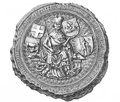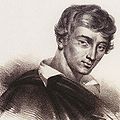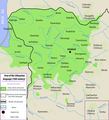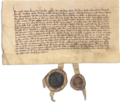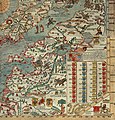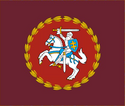Portal:Lithuania
Welcome to the Lithuania Portal — Sveiki atvykę į Lietuvos Portalą
Lithuania (/ˌlɪθjuˈeɪnijə/ LITH-yoo-AYN-ee-yə; Lithuanian: Lietuva [lʲiətʊˈvɐ]), officially the Republic of Lithuania (Lithuanian: Lietuvos Respublika [lʲiətʊˈvoːs rʲɛsˈpʊblʲɪkɐ]), is a country in the Baltic region of Europe. It is one of three Baltic states and lies on the eastern shore of the Baltic Sea. It borders Latvia to the north, Belarus to the east and south, Poland to the south, and Russia to the southwest, with a maritime border with Sweden to the west. Lithuania covers an area of 65,300 km2 (25,200 sq mi), with a population of 2.86 million. Its capital and largest city is Vilnius; other major cities are Kaunas, Klaipėda, Šiauliai and Panevėžys. Lithuanians belong to the ethnolinguistic group of the Balts and speak Lithuanian, one of only a few living members of the Baltic branch of the Indo-European language family, which is also the most widely spoken language of the branch.
For millennia, the southeastern shores of the Baltic Sea were inhabited by various Baltic tribes. In the 1230s, Lithuanian lands were united for the first time by Mindaugas, who formed the Kingdom of Lithuania on 6 July 1253. Subsequent expansion and consolidation resulted in the Grand Duchy of Lithuania, which by the 14th century was the largest country in Europe. In 1386, the Grand Duchy entered into a de facto personal union with the Crown of the Kingdom of Poland. The two realms were united into the bi-confederal Polish-Lithuanian Commonwealth in 1569, forming one of the largest and most prosperous states in Europe. The Commonwealth lasted more than two centuries, until neighbouring countries gradually dismantled it between 1772 and 1795, with the Russian Empire annexing most of Lithuania's territory. Towards the end of World War I, Lithuania declared Independence in 1918, founding the modern Republic of Lithuania. In World War II, Lithuania was occupied by the Soviet Union, then by Nazi Germany, before being reoccupied by the Soviets in 1944. Lithuanian armed resistance to the Soviet occupation lasted until the early 1950s. On 11 March 1990, a year before the formal dissolution of the Soviet Union, Lithuania became the first Soviet republic to break away when it proclaimed the restoration of its independence.
Lithuania is a developed country with a high income, advanced economy, ranking 37th in the Human Development Index (HDI) and 19th in the World Happiness Report. Lithuania is a member of the European Union, the Council of Europe, the eurozone, the Nordic Investment Bank, the Schengen Agreement, NATO, and OECD. It also participates in the Nordic-Baltic Eight (NB8) regional co-operation format. (Full article...)
Selected article -
Jogaila (Lithuanian: [jɔˈɡâːɪɫɐ] ; c. 1352/1362 – 1 June 1434), later Władysław II Jagiełło (Polish: [vwaˈdɨswaf jaˈɡʲɛwwɔ] ), was Grand Duke of Lithuania (1377–1381 and 1382–1401), later giving the position to his cousin Vytautas in exchange for the title of Supreme Duke of Lithuania (1401–1434) and then King of Poland (1386–1434), first alongside his wife Jadwiga until 1399, and then sole ruler of Poland. Born a pagan, he converted to Catholicism in 1386 and was baptized as Ladislaus (Polish: Władysław) in Kraków, married the young Queen Jadwiga, and was crowned King of Poland as Władysław II Jagiełło. In 1387, he converted Lithuania to Catholicism. His own reign in Poland started in 1399, upon the death of Queen Jadwiga, lasted a further thirty-five years, and laid the foundation for the centuries-long Polish–Lithuanian union. He was a member of the Jagiellonian dynasty in Poland that bears his name and was previously also known as the Gediminid dynasty in the Grand Duchy of Lithuania. The dynasty ruled both states until 1572, and became one of the most influential dynasties in late medieval and early modern Europe.
Jogaila was the last pagan ruler of medieval Lithuania. After he became King of Poland, as a result of the Union of Krewo, the newly formed Polish-Lithuanian union confronted the growing power of the Teutonic Order. The allied victory at the Battle of Grunwald in 1410, followed by the Peace of Thorn, secured the Polish and Lithuanian borders and marked the emergence of the Polish–Lithuanian alliance as a significant force in Europe. The reign of Władysław II Jagiełło extended Polish frontiers and is often considered the beginning of Poland's Golden Age. (Full article...)General images
Did you know -

- ...Lithuania, together with Latvia and Estonia, in 1989 formed a human chain – Baltic Way which connected the three Baltic states capitals?
Constitution of May 3 - ...The Constitution of May 3 was the first constitution in Europe and second in the world after United States Constitution of 1788?
- ...Lithuania-born political activist Michael Oliver attempted to create a sovereign micronation Republic of Minerva?
- ... that during the inaugurations of Lithuanian monarchs, Gediminas' Cap (depicted) was placed on the monarch's head by the bishop of Vilnius?
- ... that in the lead-up to the 4th Congress of the Communist Party of Lithuania in Moscow in 1924, party organizations inside Lithuania held clandestine district conferences?
- ... that after being arrested for organizing a general strike in 1920, S. Girinis was sent to the Soviet Union following a Soviet-Lithuanian exchange of political prisoners?
Selected images
Topics
Military of Lithuania
| ||||||||||||||
|---|---|---|---|---|---|---|---|---|---|---|---|---|---|---|
|
| Public holidays in Lithuania | |||
|---|---|---|---|
| Date | English name | Local name | Remarks |
| 1 January | New Year's Day | Naujųjų metų diena | |
| 16 February | Day of Restoration of the State of Lithuania (1918) | Lietuvos valstybės atkūrimo diena | |
| 11 March | Day of Restoration of Independence of Lithuania (1990) | Lietuvos nepriklausomybės atkūrimo diena | |
| Moveable Sunday | Easter Sunday | Šv. Velykos | Commemorates resurrection of Jesus. The first Sunday after the full moon that occurs on or soonest after 21 March. |
| The day after Easter Sunday | Easter Monday | Antroji šv. Velykų diena | |
| 1 May | International Workers' Day | Tarptautinė darbo diena | |
| First Sunday in May | Mother's Day | Motinos diena | |
| First Sunday in June | Father's Day | Tėvo diena | |
| 24 June | St. John's Day / Day of Dew | Joninės / Rasos | Celebrated according to mostly pagan traditions (Midsummer Day, Saint Jonas Day). |
| 6 July | Statehood Day | Valstybės (Lietuvos karaliaus Mindaugo karūnavimo) ir Tautiškos giesmės diena | Celebrates the 1253 coronation of Mindaugas, the first King of Lithuania, and the national anthem of Lithuania. |
| 15 August | Assumption Day | Žolinė (Švč. Mergelės Marijos ėmimo į dangų diena) | Also marked according to pagan traditions, celebrating the goddess Žemyna and noting the mid-August as the middle between summer and autumn. |
| 1 November | All Saints' Day | Visų šventųjų diena | Halloween is increasingly popular and is also informally celebrated on the eve (31 October). |
| 2 November | All Souls' Day | Mirusiųjų atminimo (Vėlinių) diena | |
| 24 December | Christmas Eve | Šv. Kūčios | |
| 25 and 26 December | Christmas Day | Šv. Kalėdos | Commemorates birth of Jesus. |
Categories
Recognized content
New articles
Rules | Match log | Results page (for watching) | Last updated: 2024-05-22 21:42 (UTC)
Note: The list display can now be customized by each user. See List display personalization for details.
- Ulyanovo, Kaliningrad Oblast (edit | talk | history | links | watch | logs | tools) by Marcin 303 (talk · contribs · new pages (10)) started on 2024-05-22, score: 40
- Kalinino, Kaliningrad Oblast (edit | talk | history | links | watch | logs | tools) by Marcin 303 (talk · contribs · new pages (10)) started on 2024-05-22, score: 60
- Republican League (Lithuania) (edit | talk | history | links | watch | logs | tools) by Augenis (talk · contribs · new pages (1)) started on 2024-05-22, score: 90
- Gromovo, Kaliningrad Oblast (edit | talk | history | links | watch | logs | tools) by Marcin 303 (talk · contribs · new pages (10)) started on 2024-05-22, score: 40
- House of Kęsgaila (edit | talk | history | links | watch | logs | tools) by +JMJ+ (talk · contribs · new pages (13)) started on 2024-05-22, score: 70
- Urbanavičius (edit | talk | history | links | watch | logs | tools) by Altenmann (talk · contribs · new pages (49)) started on 2024-05-22, score: 40
- Soviet submarine S-4 (edit | talk | history | links | watch | logs | tools) by Romanov loyalist (talk · contribs · new pages (11)) started on 2024-05-21, score: 20
- Sunday Football League (edit | talk | history | links | watch | logs | tools) by Gibbsyspin (talk · contribs · new pages (3)) started on 2024-05-21, score: 20
- Pulgis Andriušis (edit | talk | history | links | watch | logs | tools) by KrivisKrivaitis (talk · contribs · new pages (8)) started on 2024-05-20, score: 70
- Marija Teresė Rožanskaitė (edit | talk | history | links | watch | logs | tools) by Gamaliel (talk · contribs · new pages (38)) started on 2024-05-18, score: 40
- Mazowiecka street in Bydgoszcz (edit | talk | history | links | watch | logs | tools) by Wikibenchris (talk · contribs · new pages (1)) started on 2024-05-07, score: 20
- Vincas Juška (edit | talk | history | links | watch | logs | tools) by KrivisKrivaitis (talk · contribs · new pages (8)) started on 2024-05-20, score: 90
- Socialist Party (Lithuania) (edit | talk | history | links | watch | logs | tools) by Euglenos sandara (talk · contribs · new pages (1)) started on 2024-05-20, score: 90
- Klara Miuller (edit | talk | history | links | watch | logs | tools) by LinasD (talk · contribs · new pages (1)) started on 2024-05-20, score: 80
- House of Pac (edit | talk | history | links | watch | logs | tools) by Guccee (talk · contribs · new pages (7)) started on 2024-05-20, score: 100
- Juozapas Albinas Herbačiauskas (edit | talk | history | links | watch | logs | tools) by KrivisKrivaitis (talk · contribs · new pages (8)) started on 2024-05-20, score: 50
- Martynas Alekna (edit | talk | history | links | watch | logs | tools) by Hildreth gazzard (talk · contribs · new pages (160)) started on 2024-05-20, score: 20
- Battle of Reni (edit | talk | history | links | watch | logs | tools) by عبدالرحمن4132 (talk · contribs · new pages (5)) started on 2024-05-20, score: 20
- Venceslaus Agrippa Lituanus (edit | talk | history | links | watch | logs | tools) by KrivisKrivaitis (talk · contribs · new pages (8)) started on 2024-05-20, score: 60
- Optical-mechanical workshop "Oscar Richter" (edit | talk | history | links | watch | logs | tools) by LogoX (talk · contribs · new pages (1)) started on 2024-05-20, score: 20
- House of Holszański (edit | talk | history | links | watch | logs | tools) by Guccee (talk · contribs · new pages (7)) started on 2024-05-19, score: 70
- Sapira (edit | talk | history | links | watch | logs | tools) by Arminden (talk · contribs · new pages (24)) started on 2024-05-19, score: 40
- House of Ościkowicz (edit | talk | history | links | watch | logs | tools) by Heroldicas (talk · contribs · new pages (4)) started on 2024-05-19, score: 60
- House of Kieżgajło (edit | talk | history | links | watch | logs | tools) by Heroldicas (talk · contribs · new pages (4)) started on 2024-05-19, score: 70
- Henri Kantonen (edit | talk | history | links | watch | logs | tools) by Syvä-äksy (talk · contribs · new pages (31)) started on 2024-05-19, score: 30
- Maýa Musaskaýa (edit | talk | history | links | watch | logs | tools) by Lunar Spectrum96 (talk · contribs · new pages (14)) started on 2024-05-19, score: 60
- Tovste, Ternopil Oblast (edit | talk | history | links | watch | logs | tools) by Dantheanimator (talk · contribs · new pages (109)) started on 2024-05-19, score: 20
- Kazys Giedrys (edit | talk | history | links | watch | logs | tools) by Rahammz (talk · contribs · new pages (2)) started on 2024-05-19, score: 60
- 2004 Acropolis International Basketball Tournament (edit | talk | history | links | watch | logs | tools) by Dddenilson (talk · contribs · new pages (10)) started on 2024-05-18, score: 20
- European Union National Identity Cards (edit | talk | history | links | watch | logs | tools) by エンドくさん (talk · contribs · new pages (5)) started on 2024-05-17, score: 30
- 2024 Bamyan shooting (edit | talk | history | links | watch | logs | tools) by Lmpesantezt (talk · contribs · new pages (4)) started on 2024-05-17, score: 40
- Swedish expedition to Livonia (edit | talk | history | links | watch | logs | tools) by Gvssy (talk · contribs · new pages (7)) started on 2024-05-17, score: 20
- List of country subdivision flags in Europe (edit | talk | history | links | watch | logs | tools) by For the nth time (talk · contribs · new pages (3)) started on 2024-05-16, score: 60
- Roman Catholic Diocese of Minsk (1798–1869) (edit | talk | history | links | watch | logs | tools) by Oliwiasocz (talk · contribs · new pages (19)) started on 2024-05-16, score: 50
- 1991 Chechen general election (edit | talk | history | links | watch | logs | tools) by Yilku1 (talk · contribs · new pages (30)) started on 2024-05-16, score: 30
- Zbigniew Szałajda (edit | talk | history | links | watch | logs | tools) by Jmanlucas (talk · contribs · new pages (24)) started on 2024-05-15, score: 40
- Jūrė (disambiguation) (edit | talk | history | links | watch | logs | tools) by Altenmann (talk · contribs · new pages (49)) started on 2024-05-15, score: 40
- Marija's Silence (edit | talk | history | links | watch | logs | tools) by Анатолий Росдашин (talk · contribs · new pages (16)) started on 2024-05-15, score: 60
- Jūrė (edit | talk | history | links | watch | logs | tools) by Altenmann (talk · contribs · new pages (49)) started on 2024-05-15, score: 40
- List of international presidential trips made by Ilham Aliyev (edit | talk | history | links | watch | logs | tools) by Hemant Dabral (talk · contribs · new pages (98)) started on 2024-05-15, score: 40
- Ivan Kuras (edit | talk | history | links | watch | logs | tools) by Filmak2 (talk · contribs · new pages (2)) started on 2024-05-15, score: 30
- New York–Dublin Portal (edit | talk | history | links | watch | logs | tools) by Mechanical Elephant (talk · contribs · new pages (4)) started on 2024-05-14, score: 40
- Jesuit College in Minsk (edit | talk | history | links | watch | logs | tools) by Oliwiasocz (talk · contribs · new pages (19)) started on 2024-05-13, score: 30
- Joy of All Who Sorrow Church, Koterka (edit | talk | history | links | watch | logs | tools) by Oliwiasocz (talk · contribs · new pages (19)) started on 2024-05-12, score: 20
- Mariya Oryashkova (edit | talk | history | links | watch | logs | tools) by Fixer88 (talk · contribs · new pages (21)) started on 2024-05-12, score: 20
- 2024 FIBA U20 Women's EuroBasket (edit | talk | history | links | watch | logs | tools) by Maiō T. (talk · contribs · new pages (6)) started on 2024-05-12, score: 70
- House of Gasztołd (edit | talk | history | links | watch | logs | tools) by Guccee (talk · contribs · new pages (7)) started on 2024-05-12, score: 70
- Centrum Air (edit | talk | history | links | watch | logs | tools) by Antonbabich (talk · contribs · new pages (1)) started on 2024-05-12, score: 20
- Portal (sculptures) (edit | talk | history | links | watch | logs | tools) by B3251 (talk · contribs · new pages (21)) started on 2024-05-11, score: 60
- James Bosgrave (edit | talk | history | links | watch | logs | tools) by WikiOriginal-9 (talk · contribs · new pages (219)) started on 2024-05-11, score: 20
- Battle of Monastyryshche (edit | talk | history | links | watch | logs | tools) by Querty1231 (talk · contribs · new pages (4)) started on 2024-05-11, score: 20
- Mykolas Kalmantas (edit | talk | history | links | watch | logs | tools) by KrivisKrivaitis (talk · contribs · new pages (8)) started on 2024-05-11, score: 120
- Eurovision Song Contest 2025 (edit | talk | history | links | watch | logs | tools) by Will come will see (talk · contribs · new pages (2)) started on 2024-05-11, score: 30
- Battle of Monastyrische (edit | talk | history | links | watch | logs | tools) by Querty1231 (talk · contribs · new pages (4)) started on 2024-05-11, score: 20
- Konradas Aleksa (edit | talk | history | links | watch | logs | tools) by KrivisKrivaitis (talk · contribs · new pages (8)) started on 2024-05-11, score: 60
- 2002 Acropolis International Basketball Tournament (edit | talk | history | links | watch | logs | tools) by Dddenilson (talk · contribs · new pages (10)) started on 2024-05-11, score: 20
- 2001 Acropolis International Basketball Tournament (edit | talk | history | links | watch | logs | tools) by Dddenilson (talk · contribs · new pages (10)) started on 2024-05-11, score: 20
- 2024–25 EuroLeague Women (edit | talk | history | links | watch | logs | tools) by ILoveSport2006 (talk · contribs · new pages (5)) started on 2024-05-11, score: 30
- Caspar Levias (edit | talk | history | links | watch | logs | tools) by Rhaegar I (talk · contribs · new pages (4)) started on 2024-04-28, score: 20
- Fourth All-Russian Congress of the Party of Left Socialist-Revolutionaries (internationalists) (edit | talk | history | links | watch | logs | tools) by Soman (talk · contribs · new pages (23)) started on 2024-05-03, score: 30
- Kazys Ališauskas (edit | talk | history | links | watch | logs | tools) by KrivisKrivaitis (talk · contribs · new pages (8)) started on 2024-05-09, score: 70
- 2024 LKL Playoffs (edit | talk | history | links | watch | logs | tools) by KoldunMakaron (talk · contribs · new pages (1)) started on 2024-05-08, score: 50
- Petras Kirlys (edit | talk | history | links | watch | logs | tools) by KrivisKrivaitis (talk · contribs · new pages (8)) started on 2024-05-08, score: 50
- Polish Society "Oświata" (edit | talk | history | links | watch | logs | tools) by Oliwiasocz (talk · contribs · new pages (19)) started on 2024-05-08, score: 20
- BAA Training Aviation Academy (edit | talk | history | links | watch | logs | tools) by Bullet doggie (talk · contribs · new pages (2)) started on 2024-05-08, score: 50
- Otto Reinhold Ludwig von Ungern-Sternberg (edit | talk | history | links | watch | logs | tools) by Xegma (talk · contribs · new pages (6)) started on 2024-05-08, score: 20
- Linda Lambert (edit | talk | history | links | watch | logs | tools) by HRShami (talk · contribs · new pages (18)) started on 2024-05-08, score: 40
- Polish-Lithuanian ethnic conflict (edit | talk | history | links | watch | logs | tools) by Wladekimperialny (talk · contribs · new pages (0)) started on 2024-05-05, score: 70
Associated Wikimedia
The following Wikimedia Foundation sister projects provide more on this subject:
-
Commons
Free media repository -
Wikibooks
Free textbooks and manuals -
Wikidata
Free knowledge base -
Wikinews
Free-content news -
Wikiquote
Collection of quotations -
Wikisource
Free-content library -
Wikiversity
Free learning tools -
Wikivoyage
Free travel guide -
Wiktionary
Dictionary and thesaurus


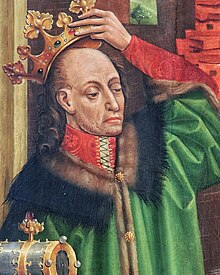














![Image 15The preservation of the Great Seal of Lithuania (pictured, dating to 1623) when concluding the Union of Lublin meant that the elected monarchs acts without being confirmed with the Lithuanian seals were void in Lithuania. These Lithuanian seals were in possession of the Lithuanian Grand Chancellor (Great Seal) and Lithuanian Vice-Chancellor [lt] (Lesser Seal). (from Grand Duchy of Lithuania)](http://upload.wikimedia.org/wikipedia/commons/thumb/e/ec/The_Great_Seal_of_Lithuania_%28with_Vytis%29_from_the_reign_of_Sigismund_III_Vasa%2C_1623.png/120px-The_Great_Seal_of_Lithuania_%28with_Vytis%29_from_the_reign_of_Sigismund_III_Vasa%2C_1623.png)

